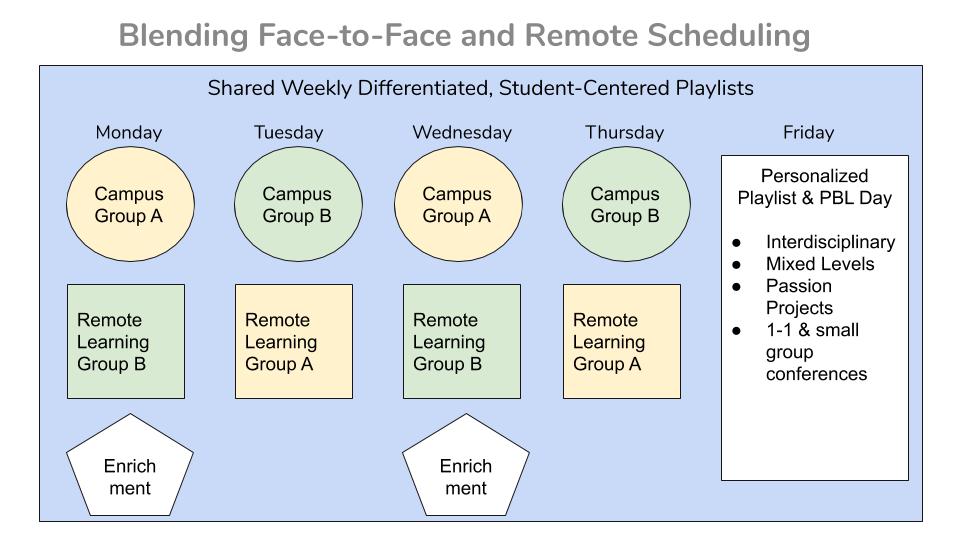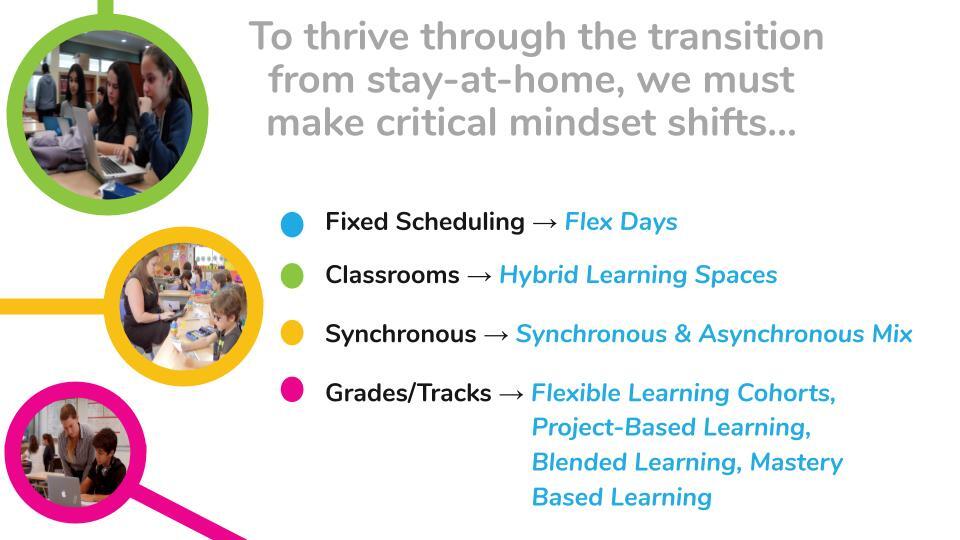Preparing for a Reimagined New School Year
As educators around the world made an unprecedented shift to remote learning, they did so from very different starting points. Some schools with a strong foundation of blended learning already had essential tools implemented, like a Learning Management System, and faculty with proficiency in blended learning, making the transition more manageable. Other schools found themselves scrambling to implement systems and train teachers overnight to ensure that learning could continue in some format. Regardless of where they started, educators have been united in a moment of collective, albeit disruptive, innovation as unprecedented as the moment itself, rising to the challenge of innovation in action.
Despite the incredible progress made, educators remain similarly united in confusion and concern over a sustainable path forward through extended remote or hybrid learning periods. In thinking about this transition, we must make key mindset shifts from what have historically been reliable conventions to much more iterative, flexible models. These shifts may include the considerations listed in the graphic below.
We don’t know what fall 2020 will look like for schools. Some will consider structures that rotate groups of students on campus within an alternating day or week schedule like the one below.
Others will contend with families whose children will have to continue remote learning even if the greater majority of their peers return to school. As leaders and teachers navigate the uncertain and unpredictable future, they will need to rely on a steady compass and prepare for the few realities we can reasonably predict.
Reality #1: The Future Will be Blended
Schools  with strong foundations of blended learning practices made the transition to remote learning with greater ease to both teachers and their communities. When schools reopen, there will be a need to continue some aspects of remote learning in a blended face-to-face environment. In this manner, schools will be able to implement pedagogical structures that allow for a less abrupt, polarized experience as students move onto and off of campus in cohorts or waves. Teachers and leaders can leverage blended models, such as the Playlist model, to create a better balance of synchronous group learning and asynchronous personalized learning than we have seen many achieve during this initial remote learning transition.
with strong foundations of blended learning practices made the transition to remote learning with greater ease to both teachers and their communities. When schools reopen, there will be a need to continue some aspects of remote learning in a blended face-to-face environment. In this manner, schools will be able to implement pedagogical structures that allow for a less abrupt, polarized experience as students move onto and off of campus in cohorts or waves. Teachers and leaders can leverage blended models, such as the Playlist model, to create a better balance of synchronous group learning and asynchronous personalized learning than we have seen many achieve during this initial remote learning transition.
Reality #2: Schools Will Schedule the Year in Phases
The practice of setting a master schedule at the start of the year will likely fall by the wayside. Instead, schools will consider phases of operation. Leaders opening schools in the fall in a hybrid combination of remote and on-campus learning must anticipate an iterative path based on implementation feedback. Even when schools can reopen entirely, leaders will be preparing for waves of remote learning. It is quite possible that some will consider year-round scheduling with shorter breaks to rotate cohorts of students onto and off campus over a more elongated period.
Reality #3: Teachers Will Upskill Continuously to Engage Students
As our LINC team has supported thousands of teachers through the transition to remote learning, we have heard countless say, “I feel like I’m learning how to do my job as I’m doing my job.” Never before has a profession requiring higher education and years of experience to master undergone such a rapid, pivotal shift in practice. This is a singular moment in which educators are being required to step completely outside longstanding “best practices” of the teaching profession while maintaining the same standard of performance. This is the time for teachers to become pedagogical problem solvers that can facilitate student-centered learning experiences through multiple delivery channels. In order to support this significant undertaking, now more than ever, leaders will need to ensure ongoing, professional development that encourages and rewards innovation in action.
Reality #4: Mastery of Technology is Not Equal to Great Pedagogy
There’s no doubt that educators need to maximize the use of multiple digital tools and blended models to be able to facilitate remote, hybrid, and blended learning. However, as one visionary teacher told us, “We cannot solve an outside-the-box challenge like COVID-19 with inside-the-box solutions.” Transferring traditional, whole classroom teaching to the virtual world should not be our goal. We need to facilitate student-centered, authentic learning experiences.
There hasn’t been a time in history when personalized learning was more important. This is because every learner’s intellectual and emotional individuality is compounded by his or her living and homeschooling circumstances. Some students have more resources for learning such as better wifi and access to devices, and others have more support from their parents. Therefore, we need to apply pedagogical problem solving to our use of technology to ensure equitable opportunities for learning.
A Path Forward in Uncertain Times
 All of this begs the question - How can leaders confidently reimagine and operationalize learning in light of these and other unforeseen realities? When we work with teachers to reimagine lessons to put innovation at the center, we emphasize the critical importance of standards-alignment. On a macro level, school leaders can do the same. By identifying foundational principles of learning, mission-specific community standards, and critical learning outcomes at each grade level, leaders can form a compass for navigating rapid change. After they ensure that the learning foundations are strong, we help them facilitate pedagogical experiences using the framework we developed in the book Blended Learning in Action. The PAACC Hallmarks of Effective Practice go beyond integrating digital tools and help teachers assess whether their remote or blended practices are hitting the mark for student-centered, personalized learning.
All of this begs the question - How can leaders confidently reimagine and operationalize learning in light of these and other unforeseen realities? When we work with teachers to reimagine lessons to put innovation at the center, we emphasize the critical importance of standards-alignment. On a macro level, school leaders can do the same. By identifying foundational principles of learning, mission-specific community standards, and critical learning outcomes at each grade level, leaders can form a compass for navigating rapid change. After they ensure that the learning foundations are strong, we help them facilitate pedagogical experiences using the framework we developed in the book Blended Learning in Action. The PAACC Hallmarks of Effective Practice go beyond integrating digital tools and help teachers assess whether their remote or blended practices are hitting the mark for student-centered, personalized learning.
Alongside our partners and schools, LINC is committed to reimagining education with a focus on continuous improvement, equity, and student centered learning. I'd love to learn about how you are preparing for a reimagined school year. Please share your ideas with me on Twitter @TeachOnTheEdge.
